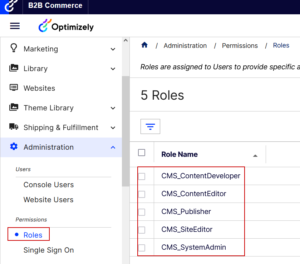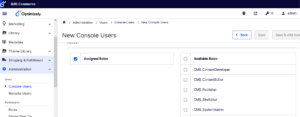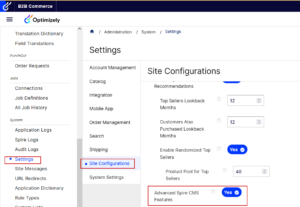What is Spire?
Spire is a brand-new CMS as well as an entirely new reference site.
The basic concepts remain the same pages are built using CMS widgets, widgets are shown on the pages, and the CMS/JavaScript Framework uses APIs to obtain data but the technology is different from our preferred classic CMS.
The primary technical goals for the rewrite of the Optimizely B2B Commerce front-end and CMS are:
- Improved upgradability for the front end
- More composable commerce pages
- Simple CMS Data Structure
- Improved page editing experience
- SEO/Server-side rendering
- Lighter JavaScript payloads
Widgets will be smaller and more focused, so users have more flexibility with how they arrange their pages.
In the previous CMS a whole page could be just one widget, which was very limiting.
Difference between Classic CMS vs Spire CMS:
Both use fundamentally different technologies. Spire CMS is built on React/Redux and Classic CMS is built on Angular.js.
| Feature/Capability | Classic CMS | Spire CMS |
| Technology | Angular.js, Foundation, TypeScript | React, Redux, TypeScript, Node |
| Front-End Upgrade Model | Merge as desired | Automated |
| Styling Approach | Cascading Style Sheets, base.css | Style Guide, user-configurable, styled-components |
| Structure by website | Themes | Content Library |
| Server/Front-End Load | Heavy Front-End, API-only on back end | Hybrid, some on front end mixed with some on back end |
| Widget Construction | Custom created | Built on Mobius and then customized |
| Widget Code | C#/TypeScript | TypeScript |
| Widget Extensibility | New widgets | New widgets, property injection or handler chain |
| Widget Sizing? reference site | Larger widgets | Smaller, more granular widgets |
| SPA (single-page app) | Yes | Yes |
| Supports GTM, Chat and other javascript-based extension | Yes | Yes |
| Build Process | Grunt | Webpack |
| Hot module replacement | No | Yes |
| SEO Page for bots | Separate page | No longer needed |
| Accessibility | By extension | Reference site includes accessibility features |
| Responsive Preview | By resizing screen | Toggle to change view |
Optimizely support Classic CMS:
All clients may now benefit from our Spire CMS and Storefront technology, independent of cloud or on-premises deployment.
As a result, we are formally giving end of life notice for our Classic (i.e. Angular) CMS and Storefront technologies.
– Who is Impacted: Customers who have a website built on our Classic (i.e., Angular) CMS & Storefront technology.
– Who is Not Impacted: Customers that already have their sites on our Spire (i.e., React) CMS & Storefront technology.
The following timeline outlines the three-year end-of-life plan:
- 2022 (Year One)– Continue to add new features to Classic
- We will continue adding new capabilities to both Classic & Spire throughout 2022. This includes adding new features and enhancements to existing features.
- 2023 & 2024 (Years Two & Three)– Make bug and security fixes to Classic
- New features and capabilities will be added only to Spire. We will then address base code bugs and critical security issues in Classic.
- January 1, 2025– End of life for Classic
- This will be the official end of life for Classic. There will be no base code changes made to Classic after this date.
Spire CMS Roles:
Spire CMS has the following permission roles:
- CMS_ContentEditor,
- CMS_SiteEditor,
- CMS_Publisher
- CMS_SystemAdmin
- CMS_ContentDeveloper
Go to admin and navigating to Administration > Permissions > Roles:

Each role lets users perform some actions while blocking other actions. Choosing the roles, you want a user to have may be done by navigating to Administration > Users > Console Users.

CMS_ContentEditor
Content editors can do the following:
- Content
- Add widgets to a content page
- Delete widgets from a content page
- Rearrange widgets on a content page
- Edit existing content widgets on any page (commerce and content)
- Pages
- Create new content pages
- Delete content pages
- Create a page variant
- Delete a page variant
- Copy a page
- Rearrange pages in the page tree
CMS_SiteEditor
Site editors can do the following:
- Content
- All CMS_ContentEditoractions
- Update content
- Edit settings and content of commerce widgets
- Pages
- Compose commerce pages
- Add widgets to a commerce page
- Delete widgets from a commerce page
- Rearrange widgets on a content page
CMS_Publisher
Publishers can do the following:
- Approve content for users who do not have publishing permissions
- Publish content, including:
- Bulk publishes
- Future publishes
- Rollback
- Immediate publish
CMS_SystemAdmin
System administrators can do the following:
- All actions listed in CMS_ContentEditor, CMS_SiteEditor, and CMS_Publisherroles
- Edit a site’s global style guide.
CMS_ContentDeveloper
- To assign this role, first enable the setting Advanced Spire CMS Features in the Admin Console under Administration > System > Settings > Site Configurations > Widgets.

- Content developers can add and edit content in the Code Snippet Other user roles can view the Code Snippet widget.
- Only CMS_ContentDeveloper and CMS_SystemAdmin can add and edit it.
Conclusion:
This is a summary highlighting how to learn Spire version in Optimizely B2B Commerce cloud. It is easy to understand the above points. In my next blog, I will explain Spire architecture and how to start spire project.
For more information, contact our commerce experts today.


Great going Shashi!! Very detailed and informative. Keep up the good work.
Thanks Kanishk